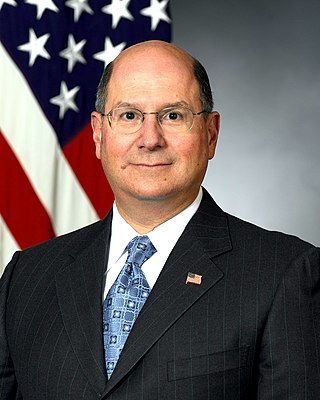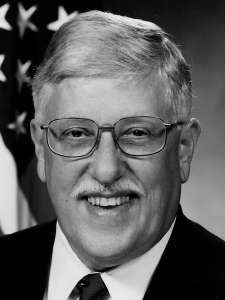
Northrop Grumman Corporation is an American multinational aerospace and defense company. With 95,000 employees and an annual revenue in excess of $30 billion, it is one of the world's largest weapons manufacturers and military technology providers. The firm ranked No. 101 on the 2022 Fortune 500 list of America's largest corporations.
TRW Inc. was an American corporation involved in a variety of businesses, mainly aerospace, electronics, automotive, and credit reporting. It was a pioneer in multiple fields including electronic components, integrated circuits, computers, software and systems engineering. TRW built many spacecraft, including Pioneer 1, Pioneer 10, and several space-based observatories. It was #57 on the 1986 Fortune 500 list, and had 122,258 employees. The company was called Thompson Ramo Wooldridge Inc., after the 1958 merger of the Ramo-Wooldridge Corporation and Thompson Products. This was later shortened to TRW.

The National Reconnaissance Office (NRO) is a member of the United States Intelligence Community and an agency of the United States Department of Defense which designs, builds, launches, and operates the reconnaissance satellites of the U.S. federal government. It provides satellite intelligence to several government agencies, particularly signals intelligence (SIGINT) to the National Security Agency (NSA), imagery intelligence (IMINT) to the National Geospatial-Intelligence Agency (NGA), and measurement and signature intelligence (MASINT) to the Defense Intelligence Agency (DIA). The NRO announced in 2023 that it plans within the following decade to quadruple the number of satellites it operates and increase the number of signals and images it delivers by a factor of ten.
Lockheed Martin Space is one of the four major business divisions of Lockheed Martin. It has its headquarters in Littleton, Colorado, with additional sites in Valley Forge, Pennsylvania; Sunnyvale, California; Santa Cruz, California; Huntsville, Alabama; and elsewhere in the United States and United Kingdom. The division currently employs about 20,000 people, and its most notable products are commercial and military satellites, space probes, missile defense systems, NASA's Orion spacecraft, and the Space Shuttle external tank.
Northrop Grumman Electronic Systems (NGES) was a business segment of Northrop Grumman from 1996 to 2015, until a reorganization on January 1 2016 merged other Northrop Grumman businesses into NGES to form a new segment called Mission Systems. NGES had originally been created by Northrop Grumman's acquisition of Westinghouse Electronic Systems Group in 1996. The Electronic Systems sector was a designer, developer, and manufacturer of a wide variety of advanced defense electronics and systems. The division had 120 locations worldwide, including 72 international offices, and approximately 24,000 employees; accounting for 20% of company sales in 2005.
The Aerospace Corporation is an American nonprofit corporation that operates a federally funded research and development center (FFRDC). The corporation provides technical guidance and advice on all aspects of space missions to military, civil, and commercial customers. As the FFRDC for national-security space, Aerospace works closely with organizations such as the United States Space Force (USSF) and the National Reconnaissance Office (NRO) to provide "objective technical analyses and assessments for space programs that serve the national interest". Although the USSF and NRO are primary customers, Aerospace performs work for civil agencies such as NASA and NOAA as well as international organizations and governments in the national interest. Aerospace, as part of its charter, also provides expertise to commercial entities, both established companies and startups, domestically and abroad.

Donald Charles Winter is an American technologist and business leader who served as United States Secretary of the Navy. A former top executive of TRW, Aerospace & Defense, he was nominated in 2005 by President George W. Bush, confirmed by the United States Senate, and took the oath of office on January 3, 2006. In January 2009 Defense Secretary Robert Gates requested that Winter remain in office until President Obama picked his successor on March 13, 2009. He resigned on March 13.

The National Polar-orbiting Operational Environmental Satellite System (NPOESS) was to be the United States' next-generation satellite system that would monitor the Earth's weather, atmosphere, oceans, land, and near-space environment. NPOESS satellites were to host proven technologies and operational versions of sensors that were under operational-prototyping by NASA, at that time. The estimated launch date for the first NPOESS satellite, "C1" or "Charlie 1" was around 2013. Issues with sensor developments were the primary cited reason for delays and cost-overruns.

Roadway air dispersion modeling is the study of air pollutant transport from a roadway or other linear emitter. Computer models are required to conduct this analysis, because of the complex variables involved, including vehicle emissions, vehicle speed, meteorology, and terrain geometry. Line source dispersion has been studied since at least the 1960s, when the regulatory framework in the United States began requiring quantitative analysis of the air pollution consequences of major roadway and airport projects. By the early 1970s this subset of atmospheric dispersion models was being applied to real-world cases of highway planning, even including some controversial court cases.

TRW Automotive Holdings Corp. was an American global supplier of automotive systems, modules, and components to automotive original equipment manufacturers (OEMs) and related aftermarkets. Tracing its roots from TRW Inc. it was originally headquartered in Livonia, Michigan. It was created in 2002 when the aerospace company Northrop Grumman purchased TRW and sold its automotive division to Blackstone Group.

The Joshua Hendy Iron Works was an American engineering company that existed from the 1850s to the late 1940s. It was at one time a world leader in mining technology and its equipment was used in constructing the Panama Canal, amongst other major projects. The company went on to serve many different markets during the course of its existence, but is perhaps best remembered today for its contribution to the American shipbuilding industry during World War II.

The Beechcraft RC-12 Guardrail is an airborne signals intelligence (SIGINT) collection platform based on the Beechcraft King Air and Super King Air. While the US military and specifically the United States Army have numerous personnel transport variants of the King Air platforms referred to with the general C-12 designation, the RC-12 specification refers to a heavily modified platform that collects SIGINT through various sensors and onboard processors.

The Northrop Grumman Firebird is an intelligence gathering aircraft designed by Northrop Grumman's subsidiary Scaled Composites which can be flown remotely or by a pilot. At Scaled, it is known as the Model 355. It was unveiled on May 9, 2011. It was first flown in February 2010 and is considered to be an optionally piloted vehicle (OPV).

TASC, Inc., formerly known as The Analytic Sciences Corporation, is an American private defense contractor based outside Washington, D.C., in Chantilly, Virginia. Northrop Grumman owned TASC from 2001 to 2009, when it sold the unit to comply with new government conflict of interest rules.

James L. Buie was an American scientist and inventor working for TRW Inc who developed transistor–transistor logic, a form of integrated circuit technology that became widely used early in the integrated circuit industry.

Mitsubishi Space Software Co., Ltd., often abbreviated as MSS, is a corporation in the Mitsubishi Electric corporation series that develops special software, such as space systems. It belongs to the Mitsubishi Group and is one of the member companies of the Mitsubishi Public Affairs Committee.

Cygnus NG-15, previously known as OA-15, was the fifteenth launch of the Northrop Grumman robotic resupply spacecraft Cygnus and its fourteenth flight to the International Space Station (ISS) under the Commercial Resupply Services (CRS) contract with NASA. The mission launched on 20 February 2021 at 17:36:50 UTC. This is the fourth launch of Cygnus under the CRS-2 contract.
TRW Vidar was an American telecommunications company, owned by TRW Inc., that made digital telephone switches from the mid-1970s to the early 1980s. They were the first, or one of the first, companies to make such a switch. Before being acquired by TRW Inc., they were known as Vidar Corporation and later, after a buyout, they were known as American Digital Switching.

Arthur "Art" L. Money is an American engineer, businessman and government official who served as the Assistant Secretary of Defense for Command, Control, Communications and Intelligence from 7 October 1999 to 7 April 2001. He concurrently served as the Department of Defense's Chief Information Officer (CIO) from February 1998 to April 2001.

Space Park is an aerospace engineering campus occupying over 100 acres in Redondo Beach, California, since 1961, expanding in 1968 to a nearly adjacent 90 acres in Manhattan Beach.














